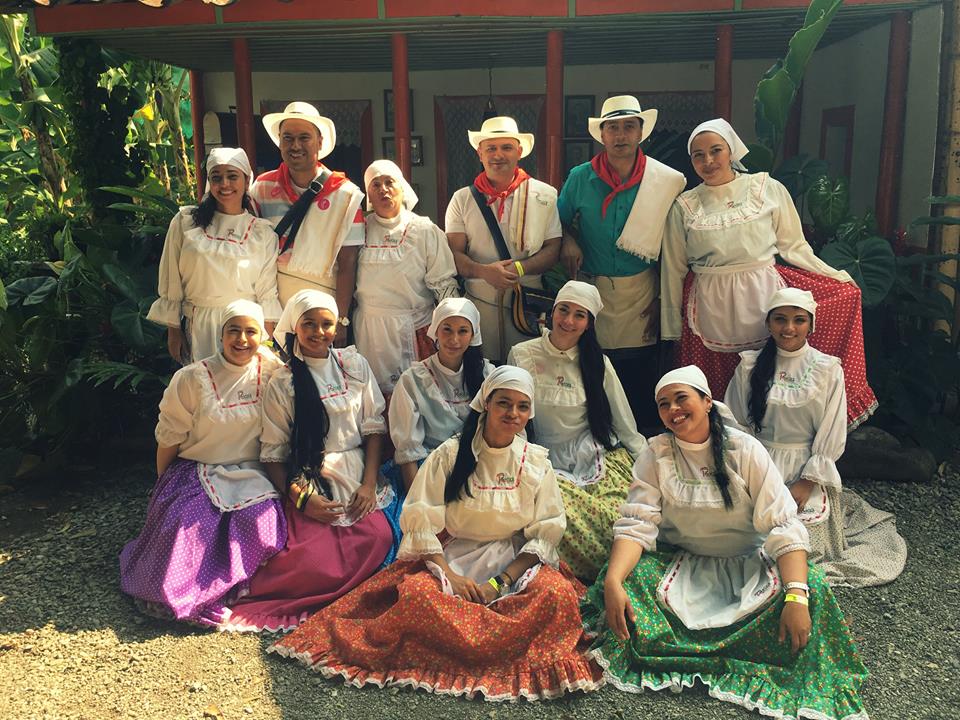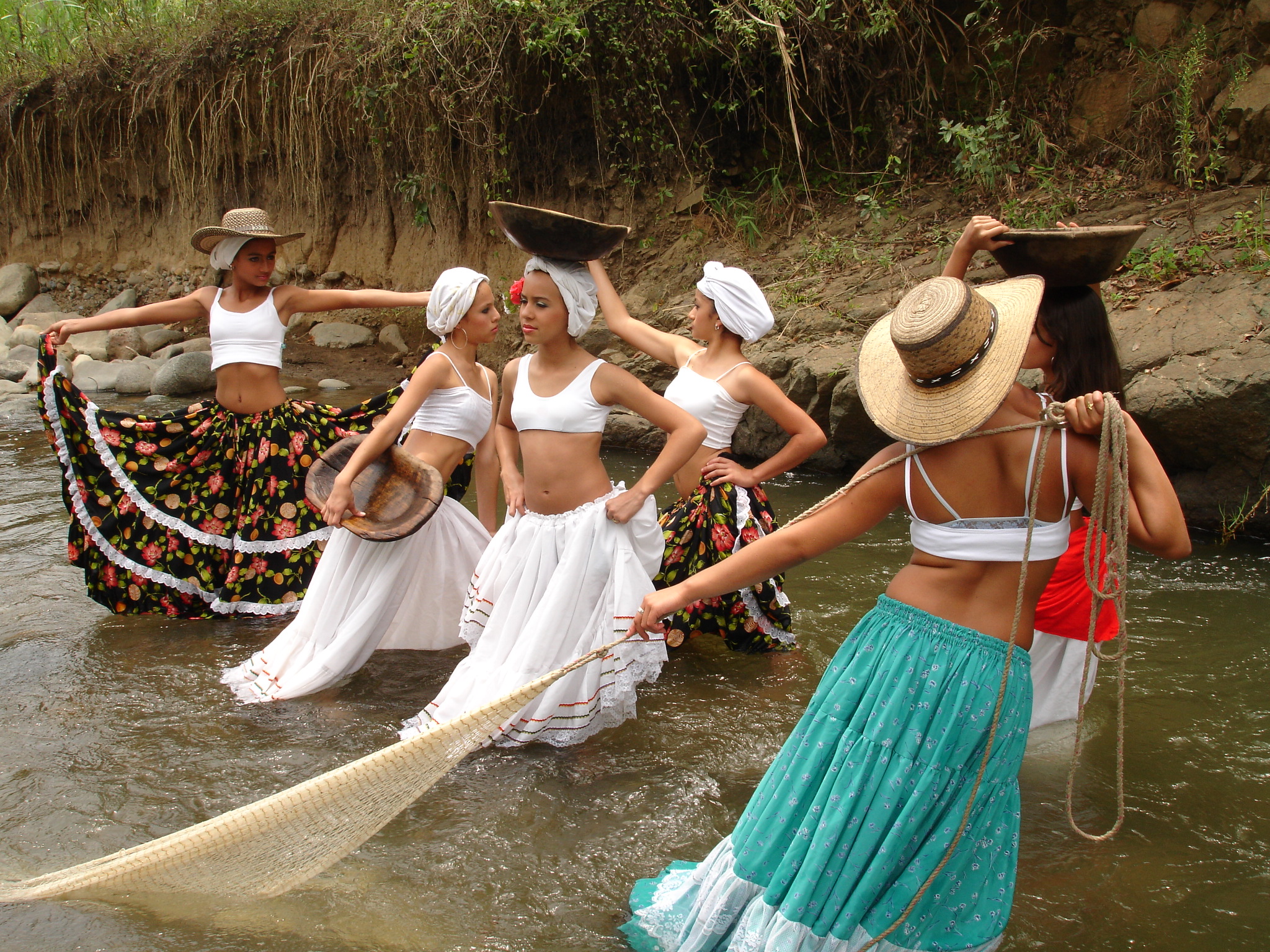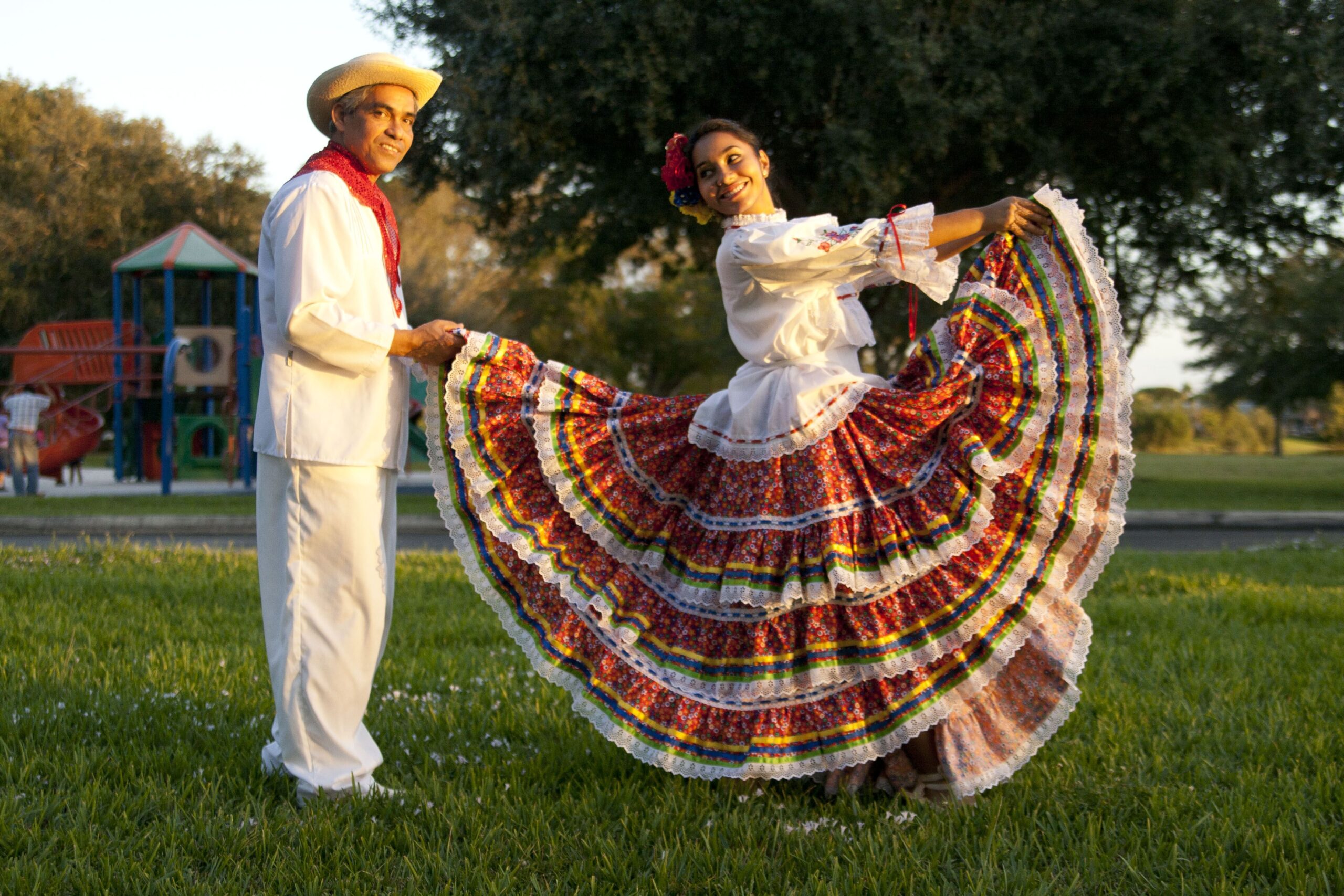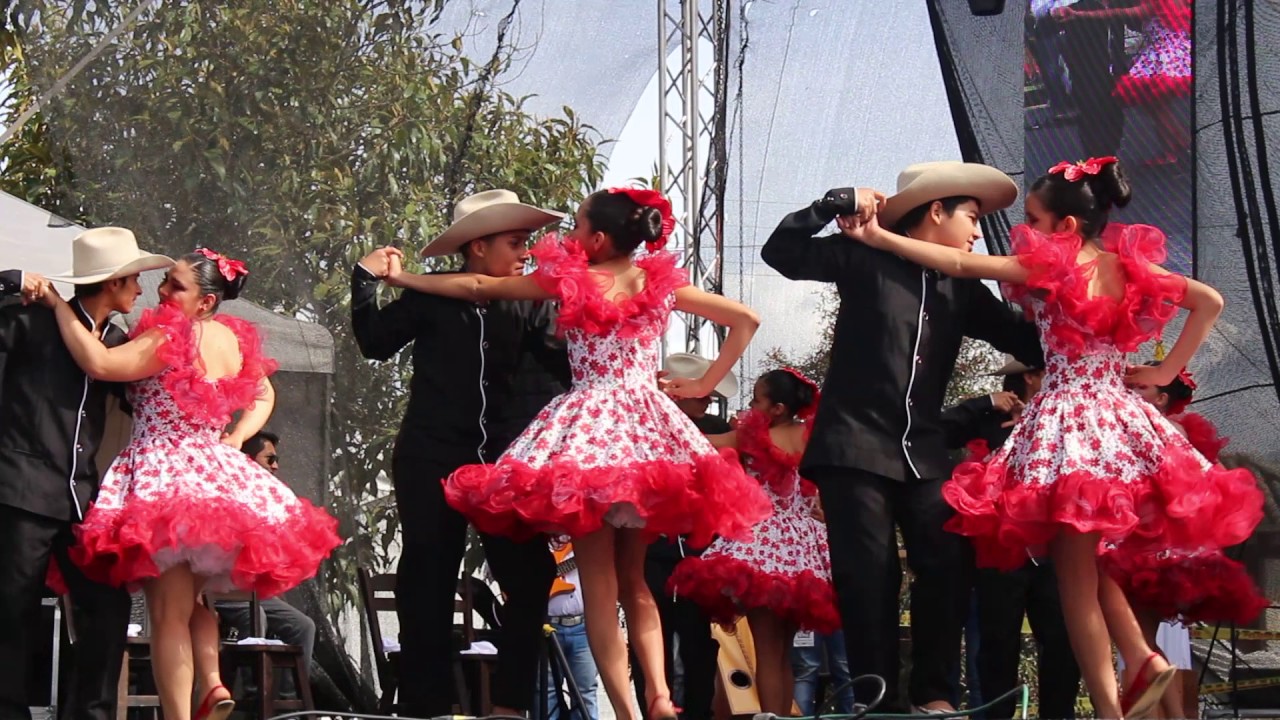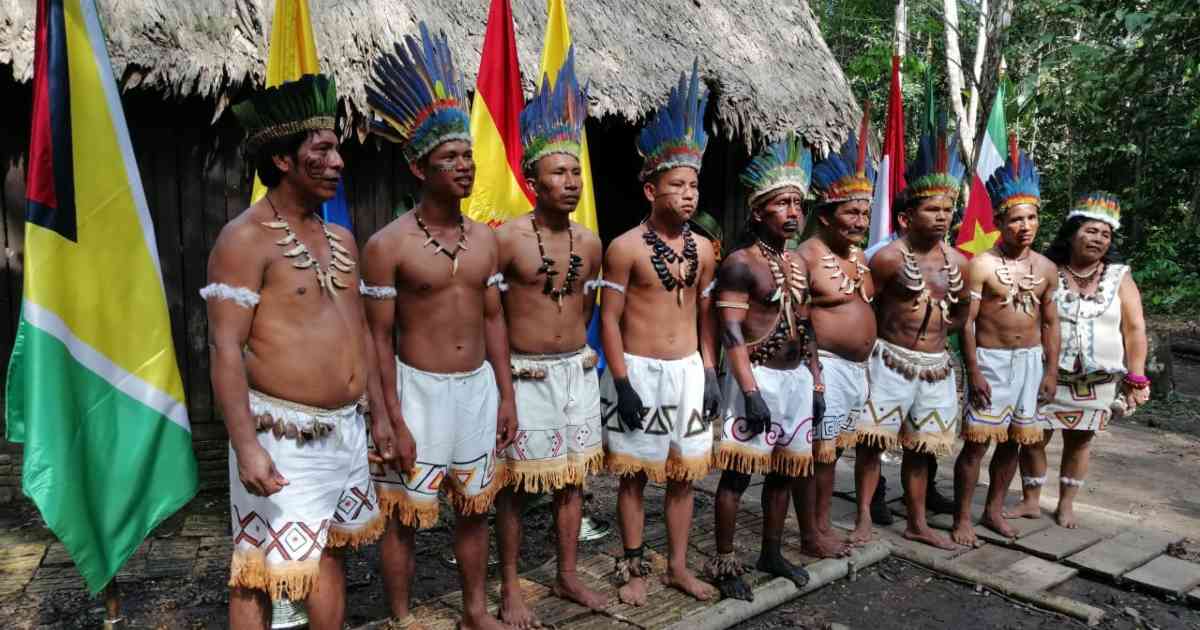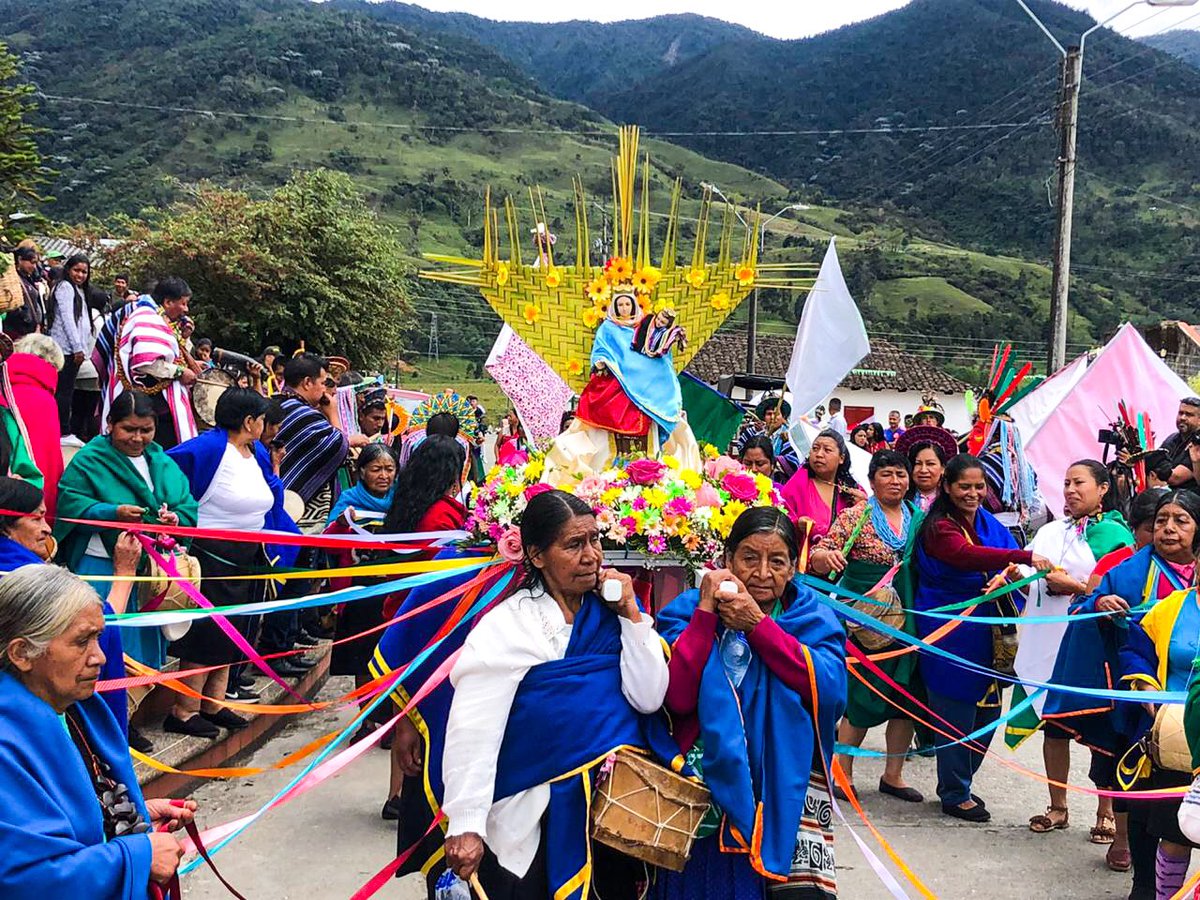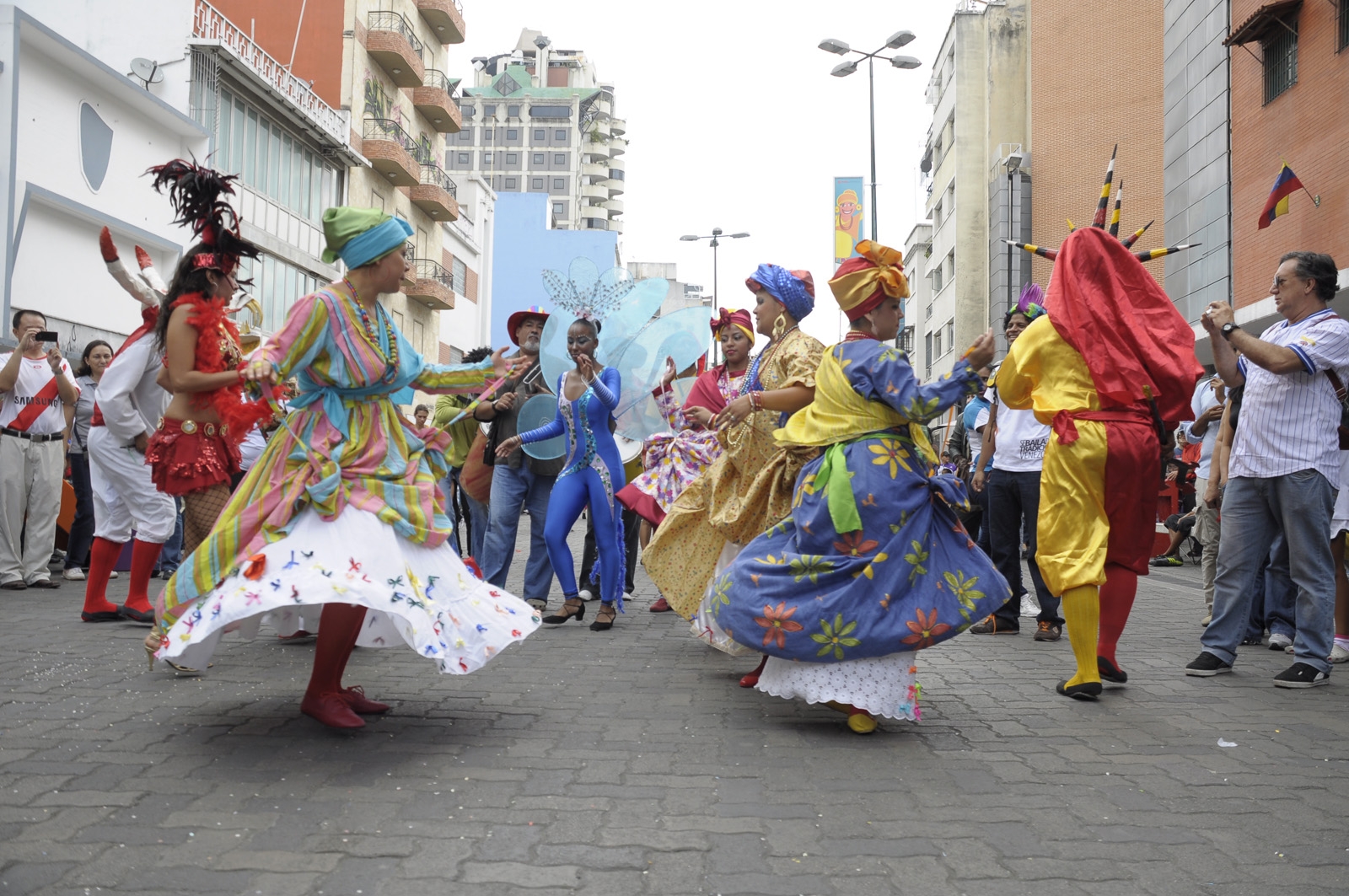One of the characteristics that best distinguishes Colombia is diversity in everything, diversity in its climate, which goes from the cold of the mountains to the depths of its Caribbean coast, the variety of its music from the melancholy bambuco to the cheerful cumbia, among so much variety, the variety of the colorful Colombian clothing could not miss.
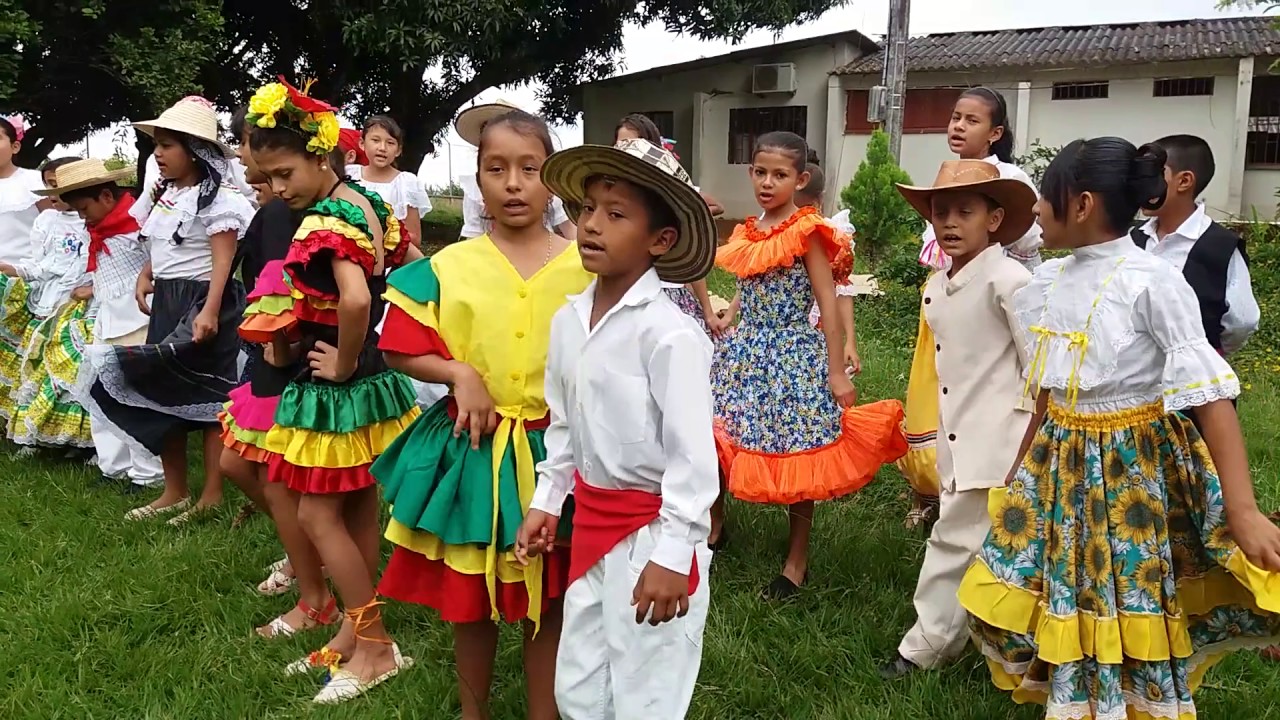
Colombian clothing
The Republic of Colombia is divided into six natural regions that are identified by different aspects, especially climate and geography. These differences give rise to cultural varieties, being a factor that identifies them the costume that is used. The mixture of the original indigenous culture, with the European conqueror and the forced African resulted in what is distinguished in Colombian clothing.
A little history
As José Moreno Clavijo recounts in his work "Cultural and Bibliographic Bulletin" published in May 1961, along the Magdalena River together with the Spanish conquerors, European costumes arrived in Colombian lands. It took a long time for the indigenous people to adopt the foreigner's way of dressing, both because of their natural mistrust and because of their resistance to a change that was imposed on them by force.
The Spanish found that the indigenous people covered their bodies with a thick cloth skirt called anaco, which consisted of a three-foot-wide cloth, with which they wrapped their hips and adjusted it to their waist with the chumbe, which was an elaborate belt. cotton and wool with very colorful colors. The anaco used by the men reached to the knees, the women wore an anaco that reached the ankles.
The women of the Indies that the European conquerors found complemented their clothing by placing the llilla on their heads, a kind of matilla that they folded over the nape of the neck holding it with the tupo, a long pin made of hollowed-out gold which was decorated with very elaborate drawings. To protect themselves from the cold they wore a long poncho made of canvas that reached to their knees.
Most of the indigenous people went barefoot, only the caciques and the most important members of the community wore the piggy bank, a leather sole that was fastened with strips of the same material that were crossed by the fingers.
In the warmer lands, the men only wore a loincloth and the women an anaco and were naked from the waist up. The Indian women used the anaco directly on the skin and it was when the European women arrived that they were forced to wear petticoats under their skirts. In the work of José Moreno Clavijo, written in 1961, one can read:
“Curious is that this clothing has been preserved almost intact through the centuries and we can see it every day through the streets of Bogota, hanging on the bodies of the Huitoto Indians who come to the capital to sell their knickknacks. Almost everyone walks barefoot on the asphalt and the only garment that links them to civic life is a felt hat just like the one worn by the office gentleman”.
Clothing of Colombia by Regions
The mixture of cultures as dissimilar as the Spanish, the indigenous and the African gave rise to a new form of cultural identity, with clothing being a way of expressing oneself. The quintessential typical Colombian clothing consists of a single-color skirt for women, usually black, which is sometimes adorned with colorful designs and other times it only has ribbons on the edges with the colors of the national flag: yellow , blue and red that achieve a very striking contrast.
The skirt is complemented by a generally white, long-sleeved blouse with a booed neckline and no neckline. Shoes are used, usually sandals, that match the design or the ribbons that adorn the skirt. Finally, it is crowned with a hat, a red or khaki scarf.
The male suit is made up to match the female suit, so it consists of black pants and a long-sleeved white shirt with a red scarf around the neck. The shoes and hat are the same as those worn by women.
But there is so much variety that Colombian clothing varies depending on the region, and each one has its own peculiarities.
The Andean region
The Andean region encompasses the departments of Antioquia, Caldas, Risaralda, Quindío and Antioquia (Coffee Region), Nariño, Huila, Tolima, Cundinamarca, Boyacá, Santander and Norte de Santander. In this region, the mestizo culture prevails with a very accentuated predominance of the Spanish descendants over the indigenous.
The men who inhabit the Andean region usually dress in black or white pants, a long-sleeved printed shirt, espadrilles, poncho, carriel, hat and scarf. The women wear a long skirt, generally adorned with small flowers, a white blouse, a tray-shaped neck, not very low-cut, and elbow-length sleeves, with a bolero of the same fabric; her hair is usually tied up in braids that fall to her shoulders.
In another version of Colombian clothing in the Andean region, the woman wears a white, tray-cut blouse made of lace and randas or handmade lace and adorned with paillette applications. She is fitted with a zipper at the back. In general, the skirt is made of satin with bright colors and its length is mid-calf. Beneath it is the petticoat with three flights. The skirt is adorned with floral motifs, either painted or die-cut from silk.
When popular festivals are celebrated in the Andean region, Colombian clothing varies. The women dress in long white dresses adorned with flowers and embroidery, to dance the sanjuanero, with shoes without heels, the men wear a white suit made up of thin fabric pants, a long-sleeved shirt, a red scarf tied around the neck and a hat. "painted".
An accessory typical of Colombian clothing is the Aguadeño hat, it is a handmade piece that has become a symbol of the Paisa culture and of the entire region. The Aguadeño hat is woven by hand with the fiber of the Iraca palm (Carludovica palmata) in the municipality of Aguadas, department of Caldas.
In the past, these hats had a fairly high crown, but they are no longer made that way, so these models are highly appreciated by collectors. Nowadays they are manufactured with the lower cup, they are short-brimmed or wide-brimmed and invariably the last is totally white and on the outside of the cup it has a black ribbon. The original and authentic Aguadeño hat is made with the fiber extracted from the heart of the Iraca palm and that is where its characteristic whiteness comes from.
The carriel or guarniel is a kind of leather bag or wallet for male use typical of the Paisa culture and Colombian clothing since colonial times. This is a garment used almost exclusively by the inhabitants of the Paisa region and that distinguishes the lords of Antioquia. The carriel was widely used by the muleteers. One of its distinctive features is the large number of pockets and compartments it has, some of which may even be "secret".
A typical representative of the woman belonging to the coffee axis is the chapolera, the woman who is in charge of harvesting the coffee, usually the chapoleras' clothing has a knotted headscarf and a palm braid hat on top. The cotton blouse is white with short sleeves, with a high neckline and bolero, it generally has ornaments consisting of embroidery, ruches, saddlebags and different laces, when the blouse is worn with long sleeves these do not have any ornaments, only lace on the elbow .
The skirts are long, up to eight inches above the ankle, made of double-round printed cotton, the print usually features flowers and is adorned with lace trims. In the lower part she wears one or two boleros and always wears petticoats, the skirt is complemented by the use of an apron for protection. As footwear the chapoleras use espadrilles. Under the scarf the hair is combed in braids tied with ribbons, with long tendrils, candongas or earrings and a large flower in the hair.
She complements her outfit with a basket woven with thin rattan with two ears that are used to be attached to the waist, this basket is used to collect the coffee directly from the branches of the coffee tree and then take it to the storage site.
The inhabitants of the Andean region proudly exhibit their colorful traditional costumes in the different festivals and fairs that are celebrated in the region, such as: The Flower Fair that is celebrated annually in the city of Medellín; The Manizales Fair, which is celebrated in January in that city and which among its events includes the region's Bullfighting Festival and the National Coffee Reign; Folk Festival and National Reign of Bambuco takes place in the city of Neiva the first week of July.
Another occasion in which the traditional Colombian clothing is used to show off are the different typical dances of the Andean area, among other dances the bambuco is included, which is considered the most representative traditional dance; El Torbellino that includes dance and song and is typical of Boyacá, Cundinamarca and Santander; La Guabina very popular in the departments of Santander, Boyacá, Tolima, Huila and formerly in Antioquia; the hall which is a variation of the European vas.
To dance La Guabina, a very special Colombian costume is used: the man wears blanket pants, fique espadrilles, a dark-colored wool cap that is covered with a small straw hat and a brightly colored shirt. . The woman adorns her figure with a dark skirt, white petticoats that reveal the lace under the skirt, espadrilles adorned with black braid, an embroidered blouse, a short mantilla that falls down the back, a straw hat and a montera.
The Pacific Region
The Pacific Region is the natural region that lies between the western Andes mountain range and the Pacific Ocean in the area called the Pacific Coast. This region encompasses the department of Chocó and the coastal areas of the departments of Valle, Cauca and Nariño. Due to its geography, this territory has a great climatic variety, but the warm climate prevails over the others.
In the Pacific Region, although there is a population of Spanish and indigenous descent, the population of African descent predominates, being one of the territories of the country with the greatest Afro-Colombian presence. Numerous cultural expressions of African origin survive in this region, which give a special color to their clothing.
Colombian clothing in this area for women consists of a long skirt that reaches the ankles and a blouse made with bright fabric of bright and striking colors that highlight the color of her skin, the blouse is adorned with figures made of thread which give it a very flowery appearance. This costume is used especially when dancing a jota, a juga or a pulley.
The men's clothing consists of a long-sleeved shirt, generally made of white silk, white pants made of denim, espadrilles made of cabuya and a thick fique fabric.
The daily and informal clothing of Colombia in the region of Valle, Cauca and Nariño, is the clothing that is conducive to warm and temperate climates in general. The woman wears linen or silk blouses or shirts with pastel colors, and miniskirts predominate. In the city of Cali and neighboring towns whose average temperature is twenty-six degrees, women do not usually wear stockings.
The informal clothing for men in the area with the highest temperatures is characterized by a short-sleeved shirt in soft fabrics and linen pants. In Nariño, the climate is generally cold, since this area is mostly located in the mountainous area of the Central Cordillera. Therefore, the use of wool clothing and sometimes ruanas is very common among its inhabitants.
To perform typical dances such as the currulao, which is a musical genre that is performed accompanied by drums, drums and clarinets, or the bunde, women adorn their figures with brightly colored skirts, a scarf and a fringed shirt while the clothing used by the men is completely white.
Pre-Columbian funeral traditions said that the dead were dressed in the most "pompous" garments, this being an inspiration for the living, who now wear their best clothes.
It is when the typical dances of the region are performed when they are best exhibited in all their splendor, among these dances, songs and rhythms are the following: The currulao, typical of Buenaventura and in general of the Pacific; the patacoré, the bereju, the juga, the maquerule, the aguabajo, the dance, the contradanza, the jota and the bunde.
These dances and songs are performed during the most important festivals and fairs in the region, such as: The Cali Fair, which is celebrated in this city between December XNUMX and XNUMX of each year and is already traditional for the people of Vallejo; Carnival of Blacks and Whites that is celebrated between January XNUMX and XNUMX in Pasto (Nariño) and was recognized as a Cultural Heritage of Humanity; and Holy Week.
The Caribbean Region
The Caribbean region of the Republic of Colombia is made up of the departments of Atlántico, Bolívar, Córdoba, Cesar, Valledupar, Riohacha, Magdalena and San Andrés. This was the first region of the country where the Spaniards arrived and it is inhabited by Wayúus in La Guajira, Arhuacos and Koguis in La Sierra Nevada and a black African population, predominant in the region.
As it is an area where hot and humid weather generally prevails, Colombian clothing in the Caribbean region consists of soft and fresh clothes, men wear soft shirts where cheerful colors stand out, wearing linen pants. In the savannahs belonging to the departments of Córdoba, Sucre, Magdalena and Bolívar it is very common for men to wear the “vueltiao” hat.
The typical clothing of men in the department of Bolívar is white linen pants, a white shirt that can be long-sleeved or short-sleeved depending on the moment, a san jacintera backpack, a “vueltiao” hat and sandals for men, and wide skirts. They are the most used by women. An accessory used above all in the city of Cartagena, by the palenqueras, who cover their heads with fabrics where they carry basins with tropical fruits, typical sweets and corn buns.
The Wayúus that inhabit the department of La Guajira are one of the few groups that use their typical clothing in daily life. Wayuu women use a beautiful and striking blanket with sandals with wool tassels of different sizes depending on social status. The men's clothing is made up of a loincloth known as a guayuco with a striking and elegant sash, the head is adorned by a cap or carriage woven in bright colors and adorned with peacock feathers, they usually go barefoot.
The vueltiao hat is an accessory of Colombian clothing that has been decreed by the congress of that country as a Cultural Symbol of the Nation. The vueltiao hat is typical of the Caribbean savannahs of Colombia, more precisely in the departments of Córdoba and Sucre. This hat comes from the Zenú indigenous culture, settled in the Sinú River region. This hat is made with the fiber of the caña flecha.
As in all its regions, the clothing of Colombia in the Caribbean region is better appreciated when the typical dances and dances of the area are performed, such as: the Mapalé, which is a very happy dance that is danced in the city of Cartagena and other towns. of the coast; The cumbia dance that represents Colombia throughout the world; the vallenato that has become popular throughout the country and in neighboring countries such as Panama, Venezuela, Ecuador and Mexico; the joint an original dance of the black slaves.
Other popular dances in the region are the Puya, a very popular dance from the Vallenata area, used in popular festivals since the end of the XNUMXth century, and the bullerengue, a musical and dance genre from the Caribbean Coast of Colombia.
The Colombian dress for dancing the cumbia is for women a wide skirt called pollera which is decorated with appliqué and ribbons and a bolero at the bottom. The blouse with bare shoulders and puffed sleeves, the colors of all the clothes are very colorful, generally with many prints. The men dress completely in white, with a long-sleeved shirt, a vueltiao hat and a red tailed scarf.
Both the showiness of the clothing and the skill in the dances are evident in the different festivals and fairs in the region such as:
The Barranquilla Carnival, where in addition to the typical costumes you can also enjoy colorful costumes; Festival of the Vallenata Legend, which is celebrated every year in Valledupar (Cesar); The Sea Fair, held annually to celebrate another anniversary of Santa María; Festival of the Wayúu Culture, takes place annually in the department of La Guajira.
Another important fair in the region is the XNUMXth of January festivities, which take place between XNUMXth and XNUMXth January in Sincelejo (Sucre), during these festivities the famous corralejas are held.
The Orinoquía Region
The Orinoquía region is located in the east of Colombia, in the geographical area that borders the Republic of Venezuela. In this area are the Llanos Orientales, an immense savannah that extends from the foothills of the eastern Andean mountain range to the river Orinoco. It is an extensive natural region that extends to Venezuela and the Guianas.
The Orinoquía region includes the department of Meta and the territories of Arauca, Casanare and Vichada. In this immense savannah landscape, the main activity is livestock, and the mestizo human type predominates, with Spanish and indigenous descendants.
The llaneros, like the gauchos of the Argentine pampas, are great horsemen, attached to the adventurous life, they generally make their living in their herds and never leave their saddle, their horse and their rope to lasso.
In general, the llanera woman wears a very wide tiered skirt that reaches the ankles, the bottom skirt is usually light or red with flowers, each tier of the skirt is profusely adorned with ribbons and flowers on the tops. seams.
The llanera woman wears a petticoat and a wide slip. The blouse used is white, with short or three-quarter sleeves, a wide neckline, high neck, adorned with ribbons and buttons at the back in the same color as the skirt. It can also be a one-piece dress with the same characteristics.
Today the plains woman also wears the same skirt but at mid-calf, on the edge she places a wide link, with a white blouse with a generous neckline, washer and short sleeves, with quotes or sole espadrilles. The women of the Orinoquía region generally prefer to wear their long loose hair adorned with a cayenne flower.
The Colombian clothing in the men of the Orinoquía region is composed of white or black pants, depending on the color of the partner's clothing.
The pants are rolled up to the middle of the leg, as if to cross a river, and he wears a white or red shirt. Another very common dress in the men of the plain is khaki pants, with a loose shirt of the same color over the pants.
His head is adorned with a wide-brimmed hat, generally a peloeguama hat, usually black or araguato. The hair and guama hat is preferred by the llaneros since, due to its nature, it is heavy and it is difficult for it to fall off with the movements of the daily tasks or with the turns of the joropo dance.
The joropo represents the quintessential dance of the Colombian and Venezuelan plains. It is a typical dance of the Spanish descendants and had its genesis in the flamenco and Andalusian dances. Traditionally the instruments to interpret it are the harp, the four and the maracas.
The llaneros flaunt their clothing and their dancing skills at the different festivals and fairs that take place in the region, such as:
The Joropo International Tournament that is held in the city of Villavicencio in the department of Meta; the Araucanidad Day that takes place every year on December XNUMX; the International Children's Festival of Llanera Music "La Palometa de Oro", is held in November in Puerto Carreño in the department of Meta; Festival of the Indigenous culture of the Cumaribo municipality.
The Amazon region
In the Republic of Colombia, the Amazon region covers the departments of Amazonas, Vichada, Vaupés, Caquetá, Putumayo, Guaviare and Guainía. This territory is inhabited by different indigenous groups that speak different languages, the most common being the Tupi language.
Due to the geographical particularities of the area, it is not possible to determine a typical costume of the region. The daily clothing used in the region is common in tropical jungle climates.
Despite this, a skirt printed with flowers, long to the knees and a white blouse adorned with necklaces and belts typical of the indigenous people, have been adopted as a local costume for women. The men wear white pants and shirts with similar collars.
The indigenous Ticunas in ancient times were half naked, they used to wear earmuffs made of wood and adorned with feathers, sometimes these earmuffs were made with metal plates. Chiefs and leading people wore bracelets adorned with animal teeth, bird feathers, and seeds.
To celebrate some rituals they wear costumes made with yanchama, which is the bark of a tree, decorated with ink made from vegetables. This suit has no sleeves and is finished off with a skirt made of palm leaves, on some occasions the leaves of the same tree arranged in strips were used. These skirts reach down to the ankles. They complement their appearance using masks made with wood from a tree called topa, they also use necklaces and crowns adorned with seeds and bird feathers.
This very special clothing was used by both men and women and also children without any discrimination.
The indigenous people of the Yaguas community use the most recognized Colombian clothing for the inhabitants of the Amazon region. In this community, men and boys wear a hairy skirt made from loose aguaje fibers.
On the neck they wear a necklace and on the ankles a bracelet also made with aguaje fibers. The women and girls of this community wear a narrow pampanilla, which is a skirt made of common cloth, leaving them naked from the waist up.
Despite the fact that the inhabitants of the Amazon region refuse to adopt the language and customs of the "whites", they use in their daily lives the clothing worn in towns and cities and the typical clothing of their region is reserved for special ceremonies.
Some festivals and fairs where the indigenous people wear their best clothes are: the Sibundoy Carnival, which is celebrated on the Wednesday before Ash Wednesday in the Sibundoy Valley; the Mocoa Carnival, which takes place in the month of December in the department of Putumayo; National and International Festival and Reign of Ecology, founded with the aim of promoting tourism in Caquetá; Folkloric Festival of San Pedro in Caquetá, is celebrated annually in Florence.
The dances where the inhabitants of the Amazon region display their best clothes are: the dance of the bride and groom, which the Guambianos perform during the marriage ceremony; the Cayuco, which is a dance that takes place during the marriage ceremony among the Huitotos indigenous people.
The Island Region
The Insular region of Colombia is not a "region" properly speaking, but the set of islands and archipelagos far from the coasts of the continent. These are the Archipelago of San Andrés and Providencia in the Atlantic Ocean and the Malpelo and Gorgona Islands in the Pacific Ocean and the Archipelago of San Bernardo in the Caribbean Sea. They do not include fluvial islands such as lakes and rivers.
Colombian clothing in the insular region is heavily influenced by Dutch culture, British culture, and African-American culture. In general, the insular clothes are light colors and light fabrics. The typical costume of the island women is a white blouse, with a high neck, long sleeves, with borders adorned with cheerful and colorful motifs. The skirt is white or, alternatively, with bright colors, it is long, wide and very light, usually reaching the ankles.
Women generally use very comfortable black closed sandals. As accessories they use ribbons or scarves that are used as adornments on the head, these are in colors that combine with the rest of the clothing. Generally the hair is collected in bows with ornaments that match the other clothes.
The Colombian clothing for the men of the Insular region consists of a long-sleeved shirt, white, very wide, elegantly cut and light fabric; gray pants or if you prefer black, made with a light material. The footwear is totally closed and black. As accessories, a hat, suspenders, chains on the shirt, a bow tie and, depending on the area, a jacket are used.
Here are some links of interest:

